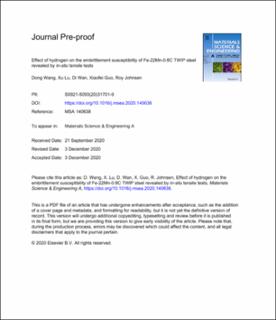| dc.contributor.author | Wang, Dong | |
| dc.contributor.author | Lu, Xu | |
| dc.contributor.author | Wan, Di | |
| dc.contributor.author | Guo, Xiaofei | |
| dc.contributor.author | Johnsen, Roy | |
| dc.date.accessioned | 2021-02-02T13:33:08Z | |
| dc.date.available | 2021-02-02T13:33:08Z | |
| dc.date.created | 2020-12-08T14:14:44Z | |
| dc.date.issued | 2020 | |
| dc.identifier.issn | 0921-5093 | |
| dc.identifier.uri | https://hdl.handle.net/11250/2725845 | |
| dc.description.abstract | The hydrogen embrittlement (HE) behavior on a Fe–22Mn-0.6C twinning-induced plasticity (TWIP) steel was investigated by tensile tests with in-situ scanning electron microscope observation combined with electron backscatter diffraction (EBSD) and electron channeling contrast imaging (ECCI) techniques. The tensile test specimens were cathodically pre-charged with hydrogen for 0, 50, 150, and 300 h, which accumulatively reduced the mechanical properties and induced a ductile-to-brittle fracture transition. The threshold of hydrogen content to trigger this ductile-to-brittle transition was further determined by combined thermal desorption spectroscopy (TDS) analysis and theoretical hydrogen diffusion calculation. During the tensile tests, intergranular secondary cracks were observed on the gauge surfaces of the specimens with pre-charged hydrogen. The low angle grain boundaries (LAGBs) exhibited better resistance to both crack initiation and propagation compared with high angle grain boundaries (HAGBs). In addition, the stress concentration together with the hydrogen effect on grain boundaries intersected with deformation twins are proposed as the reasons for the crack initiation and propagation. | en_US |
| dc.language.iso | eng | en_US |
| dc.publisher | Elsevier | en_US |
| dc.rights | Attribution-NonCommercial-NoDerivatives 4.0 Internasjonal | * |
| dc.rights.uri | http://creativecommons.org/licenses/by-nc-nd/4.0/deed.no | * |
| dc.title | Effect of hydrogen on the embrittlement susceptibility of Fe-22Mn-0.6C TWIP steel revealed by in-situ tensile tests | en_US |
| dc.type | Peer reviewed | en_US |
| dc.type | Journal article | en_US |
| dc.description.version | acceptedVersion | en_US |
| dc.source.journal | Materials Science & Engineering: A | en_US |
| dc.identifier.doi | 10.1016/j.msea.2020.140638 | |
| dc.identifier.cristin | 1857510 | |
| dc.relation.project | Norges forskningsråd: 244068/E30 | en_US |
| dc.relation.project | Norges forskningsråd: 294739 | en_US |
| dc.description.localcode | "© 2020. This is the authors’ accepted and refereed manuscript to the article. Locked until 7.12.2022 due to copyright restrictions. This manuscript version is made available under the CC-BY-NC-ND 4.0 license http://creativecommons.org/licenses/by-nc-nd/4.0/ " | en_US |
| cristin.ispublished | false | |
| cristin.fulltext | postprint | |
| cristin.qualitycode | 2 | |

